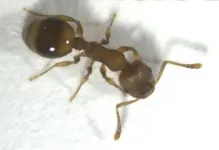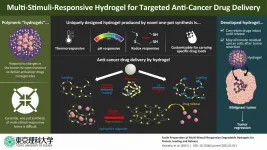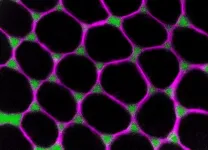Ant responses to social isolation resemble those of humans
Social isolation results in changes of behavior and activity of immune and stress genes
2021-04-07
(Press-News.org) Ants react to social isolation in a similar way as do humans and other social mammals. A study by an Israeli-German research team has revealed alterations to the social and hygienic behavior of ants that had been isolated from their group. The research team was particularly surprised by the fact that immune and stress genes were downregulated in the brains of the isolated ants. "This makes the immune system less efficient, a phenomenon that is also apparent in socially isolating humans - notably at present during the COVID-19 crisis," said Professor Susanne Foitzik, who headed up the study at Johannes Gutenberg University Mainz (JGU). The study on a species of ant native to Germany has recently been published in Molecular Ecology.
Effects of isolation in social insects little studied so far
Humans and other social mammals experience isolation from their group as stressful, having a negative impact on their general well-being and physical health. "Isolated people become lonely, depressed, and anxious, develop addictions more easily, and suffer from a weakened immune system and impaired overall health," added Professor Inon Scharf, lead author of the article and cooperation partner of the Mainz research group at Tel Aviv University in Israel. While the effects of isolation have been extensively studied in social mammals such as humans and mice, less is known about how social insects respond in comparable situations - even though they live in highly evolved social systems. Ants, for instance, live their entire lives as members of the same colony and are dependent on their colony mates. The worker ants relinquish their own reproductive potential and devote themselves to feeding the larvae, cleaning and defending the nest, and searching for food, while the queen does little more than just lay eggs.
The research team looked at the consequences of social isolation in the case of ants of the species Temnothorax nylanderi. These ants inhabit cavities in acorns and sticks on the ground in European forests, forming colonies of a few dozen workers. Young workers engaged in brood care were taken singly from 14 colonies and kept in isolation for varying lengths of time, from one hour to a maximum of 28 days. The study was conducted between January and March 2019 and highlighted three particular aspects in which changes were observed. After the end of their isolation, the workers were less interested in their adult colony mates, but the length of time they spent in brood contact increased; they also spent less time grooming themselves. "This reduction in hygienic behavior may make the ants more susceptible to parasites, but it is also a feature typical of social deprivation in other social organisms," explained Professor Susanne Foitzik.
Stress due to isolation adversely affects the immune system
While the study revealed significant changes in the behaviors of the isolated insects, its findings with regard to gene activity were even more striking: Many genes related to immune system function and stress response were downregulated. In other words, these genes were less active. "This finding is consistent with studies on other social animals that demonstrated a weakening of the immune system after isolation," said Professor Inon Scharf.
The discovery by the team of biologists led by Professor Susanne Foitzik is the first of its kind, combining behavioral and genetic analyses on the effects of isolation in social insects. "Our study shows that ants are as affected by isolation as social mammals are and suggests a general link between social well-being, stress tolerance, and immunocompetence in social animals," concluded Foitzik, summarizing the results of the Israeli-German study. Foitzik is also collaborating with her Israeli partner Professor Inon Scharf and with co-author and group leader Dr. Romain Libbrecht of JGU on a new joint project on the fitness benefits and the molecular basis of spatial learning in ants, funded by the German Research Foundation (DFG).
INFORMATION:
Related links:
https://www.blogs.uni-mainz.de/fb10-evolutionary-biology/research-groups/group-foitzik/ - Evolution and Behavioral Ecology of Ants group at the JGU Institute of Organismic and Molecular Evolution
Read more:
https://www.uni-mainz.de/presse/aktuell/10918_ENG_HTML.php - press release "Communication and waterproofing: Melting properties determine the biological functions of the cuticular hydrocarbon layer of ants" (26 Feb. 2020) ;
https://www.uni-mainz.de/presse/aktuell/7703_ENG_HTML.php - press release "Arms race between ant societies: Gene activity in defenders depends on invading slavemaking ants" (28 Feb. 2019) ;
https://www.uni-mainz.de/presse/aktuell/5983_ENG_HTML.php - press release "A study of ants provides information on the evolution of social insects" (10 Sept. 2018) ;
https://www.uni-mainz.de/presse/aktuell/5412_ENG_HTML.php - press release "Brood care gene steers the division of labor among ants" (19 June 2018) ;
https://www.uni-mainz.de/presse/aktuell/2007_ENG_HTML.php - press release "Chemical profile of ants adapts rapidly" (14 Aug. 2017)
[Attachments] See images for this press release:

ELSE PRESS RELEASES FROM THIS DATE:
2021-04-07
Cancer therapy in recent times relies on the use of several drugs derived from biological sources including different bacteria and viruses, among others. However, these bio-based drugs get easily degraded and therefore inactivated on administration into the body. Thus, effective delivery to and release of these drugs at target tumor sites are of paramount importance from the perspective of cancer therapy.
Recently, scientists have discovered unique three-dimensional, water-containing polymers, called hydrogels, as effective drug delivery systems (DDSs). Drugs loaded into these hydrogels remain relatively stable owing to the network-like structure and organic tissue-like consistency of these DDSs. Besides, drug release from hydrogels can ...
2021-04-07
By Karina Ninni | Agência FAPESP – A multidisciplinary research group affiliated with the Department of Physical Education’s Human Movement Laboratory (Movi-Lab) at São Paulo State University (UNESP) in Bauru, Brazil, measured step length synergy while crossing obstacles in patients with Parkinson’s disease and concluded that it was 53% lower than in healthy subjects of the same age and weight. Step length is one of the main variables affected by the disease.
Synergy, defined as combined operation, refers in this case to the capacity of the locomotor (or musculoskeletal) system to adapt movement while crossing an obstacle, combining factors such as speed and foot position, for example. Improving synergy in Parkinson’s patients while they ...
2021-04-07
You might not think an animal made out of stone would have much to worry about in the way of predators, and that's largely what scientists had thought about coral. Although corallivores like parrotfish and pufferfish are well known to biologists, their impact on coral growth and survival was believed to be small compared to factors like heatwaves, ocean acidification and competition from algae.
But researchers at UC Santa Barbara have found that young corals are quite vulnerable to these predators, regardless of whether a colony finds itself alone on the reef or surrounded by others of its kind. The research, led by doctoral student Kai Kopecky, appears in the journal Coral Reefs.
Kopecky and his co-authors ...
2021-04-07
Unusual diseases are medical mysteries that fascinate us, and one such disease is multiple system atrophy, or MSA. This rare neurological disorder causes failures in the proper functioning of the body's autonomic system (processes that are not under our conscious control, such as blood pressure, breathing, and involuntary movement). The resulting symptoms can look like two other types of neurodegenerative disease: Parkinson's disease and cerebellar ataxia. In fact, MSA can be separated into a parkinsonism subtype or a cerebellar subtype based on whether the resultant movement-related ...
2021-04-07
Within multicellular organisms, cells build connections with each other forming cell layers that cover the surfaces of tissues and organs and separate structures in the body. For example, the skin forms a mantle around the entire organism, and the layer of cells lining the blood vessels creates a boundary between the bloodstream and tissues. Special connections between neighbouring cells ensure that these cellular barriers are, on the one hand, stable and tight - thus protecting the body and organs against pathogens - while, on the other hand, they remain permeable to specific substances or migrating cells. This is how the cells allow dissolved ...
2021-04-07
Imagine the process of distributing electricity to homes from the power grid is like travelers boarding a train.
There are multiple steps to take before they can reach their final destination. First, they have to buy a ticket at the ticketing booth - this is where the power is generated. Then, they board a train that departs from the station - the power is transmitted over distances using transmission lines. Finally, the train takes the travelers (electricity) to their final destination. This final step of sending power to homes and businesses is called the distribution system - and it is critical that ...
2021-04-07
Today, the Muon g-2 Collaboration finally published the highly anticipated first result from its measurement of the anomalous magnetic moment of the muon, a precision quantity that offers physicists one of the most promising means to test predictions of the actual Standard Model of particle physics. The measured value, which is more precise than all values before, strengthens evidence for the emergence of new physics beyond the Standard Model, and thus for the existence of previously unknown particles or forces. The result was presented at an online ...
2021-04-07
In a new study, North Carolina State University researchers found that an outdoor science program was linked to higher average science grades and an increase in a measure of science knowledge for a group of fifth grade girls in North Carolina.
The findings, published in the International Journal of Science Education, indicates outdoor education could be a promising tool to help close gender gaps in science.
"The outdoors is a space where teachers can find tangible ways to make science come alive," said the study's lead author Kathryn Stevenson, assistant professor of parks, recreation and tourism management at NC State. "The natural environment is also a place that everybody has in common. In a way, it's also a great context for employing reform-based teaching practices ...
2021-04-07
Conspiracy theories appear to be increasing in popularity as the Covid-19 pandemic continues. But to what extent do people really agree with them, and what is the association with cognitive biases? A research team from the University of Basel studied these questions in German-speaking Switzerland and Germany.
Periods of crisis are often conducive to the emergence and spread of conspiracy theories, and the Covid-19 pandemic is a case in point. A research team led by Sarah Kuhn and Dr. Thea Zander-Schellenberg of the University of Basel has investigated the endorsement rates of coronavirus-related conspiracy theories in German-speaking Switzerland and Germany, ...
2021-04-07
Muons, particles akin to electrons, have kepts physicists' heads spinning for more than a decade, because an experimental measurement of their magnetic properties (1) disagrees with theory. Could this be caused by unknown particles or forces?
A new theoretical calculation of this parameter, involving CNRS physicists and published in the journal Nature, has reduced the discrepancy with the experimental measurement. The debate nevertheless continues.
--
For over 10 years, measurement of the magnetic properties of the muon (an ephemeral cousin of the electron) has exhibited disagreement with theoretical predictions. This ...
LAST 30 PRESS RELEASES:
[Press-News.org] Ant responses to social isolation resemble those of humans
Social isolation results in changes of behavior and activity of immune and stress genes





